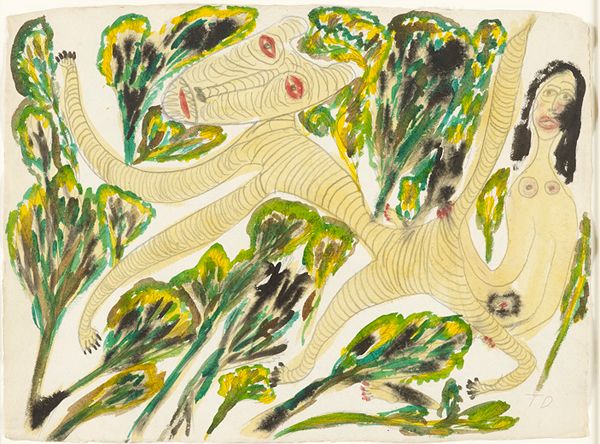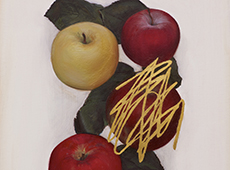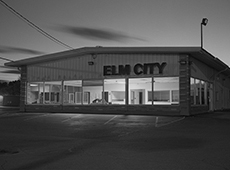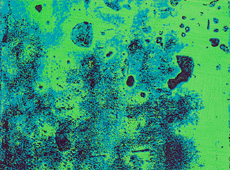…there’s also no question that locking Mr. Dial’s work into the “outsider” narrative diminishes it, turning it into artifact instead of art–-into evidence of his struggle against the often brutal and at least unforgiving injustice he was met with daily.

Thornton Dial, “Tiger Likes The Lady To Stand By.” 22 x 30 inches; mixed media on paper; 1990.
© Thornton Dial. Image courtesy Life on Mars Gallery, Bushwick.
The idea of the “outsider” in art has been troubling since it was first proposed by Roger Cardinal back in 1972. Troubling because it’s become a kind of catch all concept for artists working outside art’s mainstream (whatever that is), and more so because of the back story it implies: that self-taught artists coming up from the street or out from the field straddle the slender line that separates the exotic from the non grata. This was my definite read on Thornton Dial, whose art too often, and too unfortunately, gets filtered through the art press’ fascination with his illiteracy and with the hellish on-the-ground facts of growing up poor and black in the American South.
No question, much of Mr. Dial’s paintings, sculpture, drawings and prints carry you into a darker place–“from reflections on race and class struggle in America to haunting meditations on events of contemporary global concern” was the rather sanitized view of the High Museum, when it mounted “Hard Truths,” the traveling Dial retrospective, organized by the Indianapolis Museum of Art in 2011. (The novelist Dinitia Smith was more to the point when, in a 1997 New York Times profile, she described one of Mr. Dial’s works: “chunks of rubber hose stuck in canvas…in memory of civil rights demonstrators beaten with fire hoses.”)
But there’s also no question that locking Mr. Dial’s work into the “outsider” narrative diminishes it, turning it into artifact instead of art — into evidence of his struggle against the often brutal and at least unforgiving injustice he was met with daily.
Questioning the legitimacy of the “Insider/Outsider” tags is nothing new, especially when considering the work of Mr. Dial. Here’s Roberta Smith in 1993:
Dial’s art is not the first to imply that the inside-outside boundary is obsolete, but it emphatically serves notice that the traffic across it can move both ways. It’s gratifying to see the blue-chip style of Neo-Expressionism infused with the make-the-most-of-everything inventiveness endemic to Southern folk art — a skill honed by poverty. In Dial’s art visual richness is never equated with the more material kind. But his work is more than an outsider’s revenge on the New York art world.
Now, Outside/In, a wonderfully balanced and expansive show at Life on Mars Gallery in Bushwick, pushes the point even further.
A re-examining of the artificial classifications of what is “outsider” and “insider” and fresh eyes on the work without prejudice, will help us to learn more about ourselves and what creates deep and shared meaning in our lives.
That’s Michael David, who curated the show, which brings together sixteen of Dial’s early work on paper and sculpture with paintings, drawings and sculpture by Katherine Bradford, Farrell Brickhouse, James Castle, Chris Martin, Joan Snyder and Fred Valentine.
Again, Michael David:
There is a currency in so much of the post-Post-Modernist work I see being made now that parallels “vernacular art.” In “Meta-Modern” practice there is extension and deconstruction of formalism, which blurs lines between abstraction and figuration, and employs the use of non-traditional with traditional painting materials, which is found in much of Vernacular art. While these aforementioned evidences are obvious, it seems to me the search for a deep personal meaning, regardless of art–world classification, is the soul of this commonality.
And the “declassification” does in fact help. Having the chance to see Mr. Dial’s work liberated from the “outsider” narrative invites the viewer to instead focus on the importance of physical handling, iconography and the use of discarded materials—the appropriate starting point for a deep engagement with his good art.
Life on Mars Gallery‘s current exhibition, Outside In, is on view until March 1 (56 Bogart St., Bushwick).
Symposium: The Outside Thing. Moderated by Michael David, with Katherine Bradford, Farrel Brickhouse, Chris Martin and Joan Snyder. Sunday, 2 March, 2pm @ Life on Mars Gallery, Bushwick.
Subscribe to Tilted Arc
If you like this story, please consider subscribing. We are sticklers for privacy.
We will never sell or share your e-mail address.



